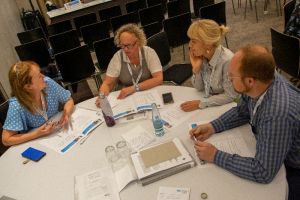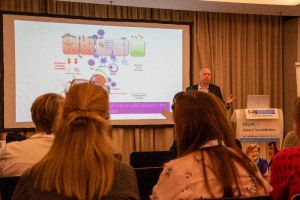ESUN22 course in Prague inspires and enlightens participants from across Europe

Course report from the European School of Urology Nursing
Before I begin, I would like to congratulate the EAUN ESUN committee for all their hard work arranging and rearranging the venue. We had a fantastic course which was everything we expected: inspiring, motivating and, best of all, it was a face-to-face meeting. This meant we could share experiences, create new contacts and learn from each other’s experiences.
Arrival
The hotel was perfect: bright and welcoming with friendly helpful staff and comfortable beds. The course commenced, following a scrumptious lunch, with an opening address and welcome by Stefano Terzoni (Milan, IT), chairperson. There were around 30 delegates in total from all around Europe, including the Czech Republic, Denmark, Greece, Italy, the UK, and Ireland. I would like to express my special thanks to Coloplast which so generously sponsored the course.
Module 1
Dr. Serena Maruccia (Milan/Monza, IT) commenced with the aetiology of the urinary tract:
a) anatomy and physiology of the urinary tract https://www.kenhub.com/en/study/anatomy-urinary-system
b) how bacteria enter the bladder in men and in women depends on many different factors, such as length of urethra, skin sensibility, placement of urethra, sexual contact, contraception, menopause, pregnancy, etc.
c) cross-contamination (hospital acquired UTI, UTI-SIRS-sepsis). Serena discussed the cross contamination, biomes and sequential organ failure assessment (SOFA) and the quick (qSOFA) assessment, which were an enlightening introduction to the course.

Group work at a participant table
Module 2
Prof. Gernot Bonkat (Basel, CH), who is Chair of the EAU guidelines on Urological Infections) spoke to us about antibiotic resistance and asymptomatic UTI. The professor enlightened us with his discussion around microbiology and antibiotic resistance (ABS). He acknowledged that there is now much more interest in infections. The abuse and misuse of antibiotics is considered to be one of the driving forces for AMR. It is estimated that at least 30% of antibiotics prescribed in outpatient settings are unnecessary. There are few antibiotics in development, due to scientific difficulties, financial and regulatory issues. In addition, new antibiotics have to be used sparingly to avoid resistance development.
Prof. Gernot Bonkat during his talk on antibiotic
resistance and asymptomatic UTI
Penicillin
Alexander Fleming, Howard Florey and Ernst Chain were awarded the Nobel Prize in 1945 for the discovery of penicillin, the world’s first broadspectrum antibiotic. Very early in the discovery, they established the ease with which bacteria could develop resistance to penicillin. In Fleming’s Nobel acceptance speech, he ended with a warning for future generations: “The thoughtless person playing with penicillin treatment is morally responsible for the death of the man who succumbs to infection with the penicillin-resistant organism.”
Module 3
What a way to celebrate your birthday! Sarah Hillery (York, GB), BAUN President, spoke about UTI in persons with catheters. She explained that highly evolved complex defences are breached when the catheter is inserted and establishes direct ‘communication’ to the outside world. Bacteria colonisation is present in urine 24-48 hours after catheter insertion and as we all know the infection risk increases with duration. Some very interesting facts (Public health England 2016/2019): in Europe, 4 million people a year develop hospital acquired infections (HAI) and 37,000 die as a direct result! Recurring CAUTI are a result of hydration, hormones, hygiene, constipation, diabetes and bladder stones. Sarah finished with some patient experiences and her personal account about her mother Val who had dementia.
All excellent faculty members
Module 4
Veronika Geng (Lobbach, DE) then spoke about UTI’s in people who use intermittent catheterisation (IC), explaining that in different countries there are different criteria for diagnosing CAUTI. A recurring UTI is defined as two proven episodes within 6 months, or 3 within a year. Obtaining the patient’s
description of a UTI, clinical symptoms etc. are important, but these alone are not sufficient to establish the diagnosis. Sending an appropriate clean specimen of urine is essential. Adherence to IC encompasses many factors with regard to socioeconomic, educational or financial status, reason for IC, complexity of procedure, independence of the individual and quality of life issues. The close relationship we have with our patients as professionals include trust, empathy and patience which are essential for a successful outcome for IC.
“If a man has no reason to do something he has a reason not to do it” – Walter Scott
“A new development is the trial set up with the MV140 vaccine for rUTI in women.”
Module 6
Eva Wallace (Dublin, IE) discussed the prevention and treatment CAUTIs, a worldwide issue which remains a severe healthcare burden with antibiotic resistance rates alarmingly high. It is the most common healthcare associated infection and 75% of UTIs are caused by catheters. There are many adverse effects of urinary catheterisation. The CDC guidelines estimate that 9,000 deaths a year could be prevented! Contamination of the sterile field (27%), the catheter (31%) and breach of the sterile barrier (38%) can occur following insertion. Almost 60% of patients report catheter complications with non-infectious complications 5 times more common. In a 2020 prospective multi-institutional study the incidence of traumatic UC was 13.4% and 1 mortality due to urosepsis resulting from catheter
balloon inflation in the urethra was reported.
Another incident reports a misplaced suprapubic catheter when it was inadvertently advanced into the proximal urethra and the balloon was inflated. This of course can be avoided by the use of the transurethral catheter safety valve (TUCSV). It is important to consider alternatives to a urinary catheter insertion. Remember: ‘no catheter no CAUTI’.
Module 7
Susanne Vahr (Copenhagen, DK) spoke about assessment of UTI in people who use IC showing us the report from the Coloplast survey identifying the different challenges according to the users and the nurses. Patients’ experience showed that their caretakers underestimate the burden of rUTIs and do not appreciate or recognise the impact of CAUTI on patients’ lives. Patients and GPs view things very differently. Assessment must include general health status, knowledge of the urinary tract, ability to understand the information, ability to perform the skill, compliance/adherence, psychological support, motivation and ability to perform the procedure supplemented with insight in the everyday life of the user of IC. This was followed with some stimulating case studies and lots of discussion about how to assess rUTIs.
Module 8
Bente Thoft (Aarhus, DK) addressed issues around patient education and how to master ISC and prevent UTI. The purpose of education is to empower the patient and/or caregiver to enable them to have more control and solve their problems. Education must be directed at both patient and caregiver, using the teach-back model or the Health-Action-Process-Approach. The goal of the teach-back method is to provide effective teaching at the literacy level of the patient or their primary learner. The health care professional must have appropriate knowledge, communication skills and attitude in order to promote confidence in the
procedure and long-term adherence! There are many factors that support adherence to ISC including the role of the instructor, the patient/partner carer, choice of catheter, use of adaptive devices, physical/psychological disability, etc. Coloplast offers a supporting tool for patient assessment and the UTI risk factor model.
Trial
Furthermore, there was an excellent discussion on the prevention of UTIs by using oestrogen, probiotics, cranberry, bladder flush with gentamycin. A new development is the trial set up with the MV140 vaccine for rUTI in women. This UTI vaccine is composed of the inactivated whole bacteria of the four most common bugs that cause UTIs in men and women (Escherichia coli, Klebsiella pneumoniae, Proteus vulgaris and Enterococcus Faecalis).
Module 9
Stefano Terzoni spoke about enhancing adherence to CAUTI guidelines stating that there are many excellent recommendations and evidence, however, do we follow all the evidence? Hospital-acquired CAUTIs are theoretically considered a “never event” and are reportable as a quality indicator just as pressure ulcers! However, there are 13,088 deaths associated with them per year in the USA. A systematic review of barriers and facilitators and strategic behavioural analysis of interventions in the field of CAUTI reduction identified 6 domains: environmental context and resources, lack of knowledge, beliefs about consequences, social influences, decision making, professional roles and identity.
“Education is the most powerful weapon that you can use to change the world” – Nelson Mandela
Houdini
How many of these domains can be modified or changed by nurses? Can they all be modified by nurses alone? An important advice for nurses is to implement and use the HOUDINI process: make the catheter disappear. It will give the benefits of using a patient-held passport to improve catheter management and enhance patient compliance. In hospitals it may seem difficult for patients to differentiate the different staff a grades and they sometimes do not know who to ask and what to do. The IDEAL discharge plan should Include, Discuss, Educate, Assess, Listen.
Shortage
The course was a great success. As a group we agreed that one of the biggest challenges we face is the global shortage/inadequate ratio of nursing staff. One big question to ask: why do nurses leave the profession? The general agreement was that nurses alone cannot solve this issue which needs to be rectified urgently. Healthcare revolves around appropriately trained and available staff supported by the policy makers who make the strategically important decisions, with significant impact on the quality and safety of patient care.
“What a fantastic course. It was wonderful to
meet up with like-minded urology nurses
from across Europe to discuss a health issue
that affects all of our patients. Together we
were able to highlight our local treatments
and management. During the group
discussions we came up with some useful,
innovative ways of highlighting issues with
CAUTI.”
Rachel Skews (GB)
“I had the privilege of attending the 5th ESUN
course in September. It was very informative,
thought-provoking and reassuring that I am
up to date with current practice. It was also
lovely to spend time with like-minded
professionals and establishing links with my
European colleagues. I would highly
recommend future events to my colleagues.”
Patricia McDermott (GK)
“The recently concluded UTI course was a
well organised event. It gave us insight into
the different practices in managing UTI not
only within UK, but in other European
countries.”
Mary Vicencio (GB)
__________________________________________________________________Mrs. Eva Wallace, ESUN faculty member, Dublin (IE)



